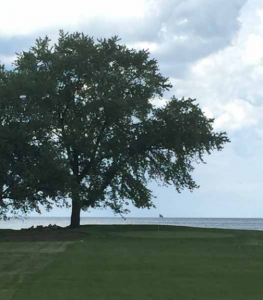It has a big budget, even bigger buzz, and some seriously colossal names connected with it — including NBC commentator Mark Rolfing, President Barack Obama, and a fella named Woods, among others. But what the South Shore and Jackson Park Golf Course Restoration Project has most of all, is the weight of some Windy City-sized expectations around its proverbial shoulders.

The new course will offer four holes along the lake, rebuilding on the existing offerings from the South Shore and Jackson Park courses.
“We’re very excited about it, that’s one of the goals, to create an urban flagship, a youth-friendly golf hub, and change things in Chicago,” explained Brian Hogan, the longtime Chicagoan, co-founder and director of the Chicago Parks Golf Alliance, the group spearheading the $30+ million project. “These courses have been here since 1899 in Jackson Park, and 1907 in South Shore, but (the goal is to) really improve them in ways that are sustainable for generations to come and make them very youth-friendly, as well.
“This has drawn a lot of national attention with Tiger Woods’ involvement, which we’re very, very thankful for.”
Woods’ TGR Design golf architecture company has been tapped to take the two historic lakeside courses on the city’s South Side (27 holes in total), and combine them into one championship track fit for the PGA Tour’s BMW Championship, youth clinics and everything in between. And while Tiger’s had his share of troubles recently (checking into a treatment facility for painkillers last month), the project hasn’t lost momentum.
 The current courses occupy lakefront land adjacent to the future home of the Barack Obama Presidential Center, and will be combined into a single 18-hole championship course, along with a short, family-friendly course and expansive teaching facility in partnership with The First Tee of Greater Chicago (see story on page 76). And while other golf architectural firms were considered, word has it Mr. Obama himself asked Tiger to be involved.
The current courses occupy lakefront land adjacent to the future home of the Barack Obama Presidential Center, and will be combined into a single 18-hole championship course, along with a short, family-friendly course and expansive teaching facility in partnership with The First Tee of Greater Chicago (see story on page 76). And while other golf architectural firms were considered, word has it Mr. Obama himself asked Tiger to be involved.
“I’d had two really good experiences with Bill Coore and Ben Crenshaw, building Kapalua on Maui and Sand Hills in Nebraska, and I was pretty sure they were going to be my guys here in Chicago,” Rolfing said. “But one day President Obama called Tiger, and effectively said, ‘Hey, there’s a project going on up in Chicago, and it’s going to be adjacent to my library and I’m really interested in it. It’s going to be the front doorstep to the library, and the future of public golf up there, and I want you to get involved.’
“Within 10 days of that call, Tiger was in Chicago, with his team. I spent the day with him up there, and it was pretty remarkable. After that day, I was convinced that it was the right fit, for both the project, and for Tiger. It wasn’t because he was going to restore the course the best way or build the best golf holes. It wasn’t about whether the 10th hole was going to be a par-3 or a par-4. It was about the impact this place can have on the community.”
Rolfing and Hogan have been working hard on outreach to the community, members of which worry that the course will become too costly for the average person. But the group plans to keep golf free for area kids, and affordable for the adults, as well. That’s the major impetus behind the project, Rolfing said — creating something special for the community.
“During that day with him, Tiger must’ve said to me 10 times, ‘Where are all the kids? Where are they?’” Rolfing said. “It was a beautiful Thursday in August, and both courses were pretty empty. Tiger immediately saw a chance to make a difference. Given his background in the game, where he was denied access, and in situations where golf wasn’t maybe affordable. He lived the experience we’re trying to change in Chicago, to make sure there is access for everybody and affordable.
‘That’s what makes this project so unique to anything else in golf, because the actual cost of the restoration is donated private money, it’s not going to have an impact on what actually has to be charged to keep the operation afloat when it’s done. It’s almost like building a park, where money is donated for the good of the community and a park is built. And that’s happened in Chicago with Millennium Park.”
We all know how that project turned out. But we’ll have to wait a while longer to see Woods’ wonder come to completion — the project is set for a 2020 opening. But with preliminary plans unveiled in June, it’s clear the course will have something for everyone.
That includes, it seems, wide fairways and big greens, six sets of tees and even caddies (in partnership with the Western Golf Association) to help you on your round. All that and more are planned for the 7,354-yard course (stretched out over a par-70 format), which will offer stunning views of Lake Michigan (including two par-3s on the water) as well as the friendly, parkland-style layout the courses have today.
“We believe in catering the golf experience to a wide swath of people — juniors, elderly, avid players, not-so-avid players,” Beau Welling, TGR Design’s senior design consultant, told the Chicago Tribune. “One of Tiger’s tenets is playability. How can we bring more people out to the golf course and allow them to have fun?”
We’re betting when it’s all said and done, the question won’t be how can they have more fun, it’ll be how could they not?
For more information, visit tgrdesign.tigerwoods.com or chicagoparksgolfalliance.org.

 ';
';
 ';
';
 ';
';
 ';
';